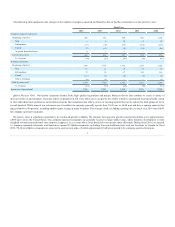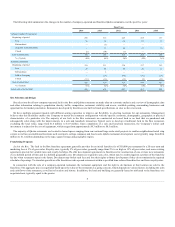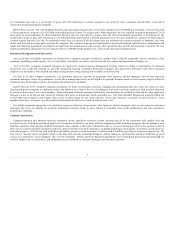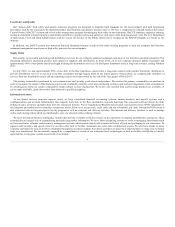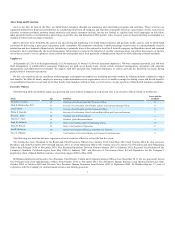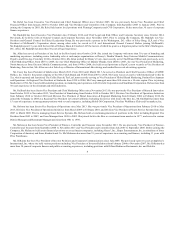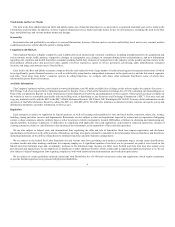Jack In The Box 2014 Annual Report Download - page 15
Download and view the complete annual report
Please find page 15 of the 2014 Jack In The Box annual report below. You can navigate through the pages in the report by either clicking on the pages listed below, or by using the keyword search tool below to find specific information within the annual report.
service offerings There are many well-established competitors. Each of our restaurants competes directly and indirectly with a large number of national and
regional restaurant chains, as well as with locally-owned and/or independent quick-service restaurants, fast-casual restaurants, casual dining restaurants,
sandwich shops and similar types of businesses. The trend toward convergence in grocery, deli and restaurant services has and may continue to increase the
number of our competitors. Such increased competition could decrease the demand for our products and negatively affect our sales and profitability. Some of
our competitors have substantially greater financial, marketing, operating and other resources than we have, which may give them a competitive advantage.
Certain of our competitors have introduced a variety of new products and service offerings and engaged in substantial price discounting in the past, and may
adopt similar strategies in the future. In an effort to increase same-store sales, we continue to make improvements to our facilities, to implement new service
and training initiatives, and to introduce new products and discontinue other menu items. However, there can be no assurance that our facility improvements
will foster increases in sales and yield the desired return on investment, that our service initiatives or our overall strategies will be successful, that our menu
offerings and promotions will generate sufficient customer interest or acceptance to increase sales, or that competitive product offerings, pricing and
promotions will not have an adverse effect upon our margins, sales results and financial condition. In addition, the success of our strategy depends on, among
other factors, our ability to motivate restaurant personnel and franchisees to execute our initiatives and achieve sustained high service levels.
Advertising and Promotion Risks. Some of our competitors have greater financial resources, which enable them to purchase significantly more
advertising, particularly television and radio ads, than we are able to purchase. Should our competitors increase spending on advertising and promotion,
should the cost of advertising increase or our advertising funds decrease for any reason, including reduced sales or implementation of reduced spending
strategies, or should our advertising and promotion be less effective than our competitors, there could be a material adverse effect on our results of operations
and financial condition. Also, the fragmentation in the media favored by our target consumers, including growing prevalence and importance of social and
mobile media, poses challenges and risks for our marketing, advertising and promotional strategies. Failure to effectively tackle these challenges and risks
could also have a materially adverse effect on our results.
Taxes. Our income tax provision is sensitive to expected earnings and, as those expectations change, our income tax provisions may vary from quarter-to-
quarter and year-to-year. In addition, from time to time, we may take positions for filing our tax returns that differ from the treatment for financial reporting
purposes. The ultimate outcome of such positions could have an adverse impact on our effective tax rate.
Risks Related to Reducing Operating Costs. In recent years, we have identified strategies and taken steps to reduce operating costs to align with the
increased Jack in the Box franchise ownership and to further integrate Jack in the Box and Qdoba brand back office functions and systems. These strategies
include outsourcing certain functions, reducing headcount, and increasing shared back office services between our brands. We continue to evaluate and
implement further cost-saving initiatives. However, the ability to reduce our operating costs through these initiatives is subject to risks and uncertainties, and
we cannot assure that these activities, or any other activities that we may undertake in the future, will achieve the desired cost savings and efficiencies.
Failure to achieve such desired savings could adversely affect our results of operations and financial condition.
Risks Related to Loss of Key Personnel. We believe that our success will depend, in part, on our ability to attract and retain the services of skilled
personnel, including key executives. The loss of services of any such personnel could have a material adverse effect on our business.
Risks Related to Government Regulations, Including Regulations Increasing Labor Costs. The restaurant industry is subject to extensive federal, state
and local governmental regulations as described in Item 1 under “Regulation.” We are subject to regulations including but not limited to those related to:
• the preparation, labeling, advertising and sale of food;
• building and zoning requirements;
• sanitation and safety standards;
• employee healthcare requirements, including the implementation and legal, regulatory and cost implications of the Affordable Care Act;
• labor and employment, including recently enacted and proposed minimum wage adjustments, overtime, working conditions, employment eligibility
and documentation, sick leave, and other employee benefit and fringe benefit requirements, and changing regulatory interpretations of federal or
state labor laws;
• the registration, offer, sale, termination and renewal of franchises;
• truth-in-advertising, consumer protection and the security of information;
• Americans with Disabilities Act;
• payment card regulation and related industry rules;
• liquor licenses; and
• climate change, including the potential impact of greenhouse gases, water consumption, or a tax on carbon emissions.
13


